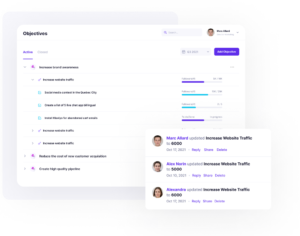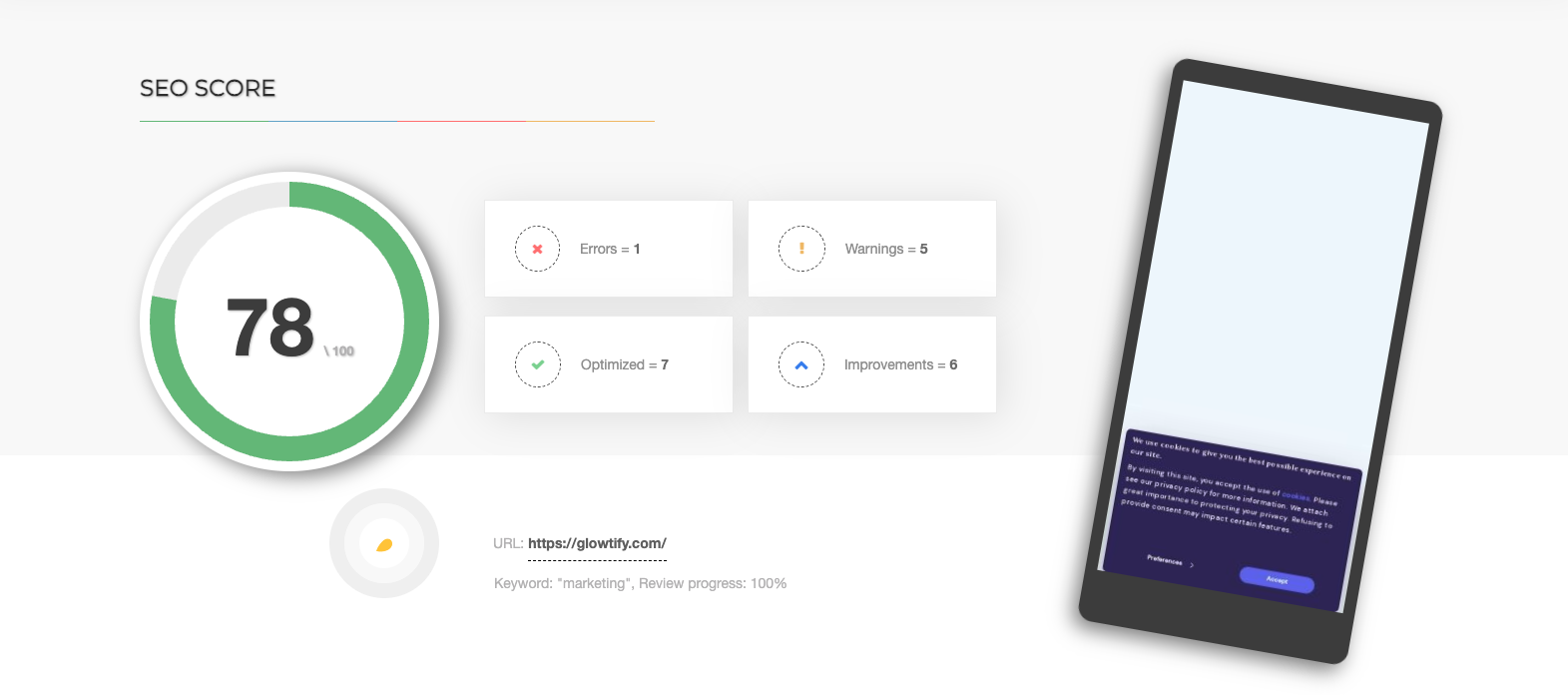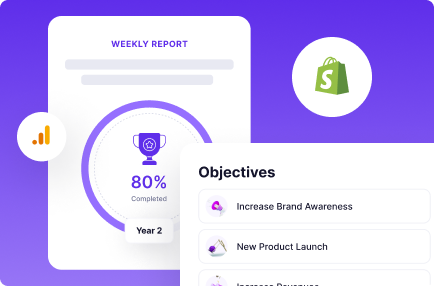Table of Contents
Many business owners know the term “OKR” but are unsure what it means or how it applies to their business. There are a lot of talks these days about OKRs vs KPIs. Both are popular performance management tools, but they are not the same.
We will explain the differences between OKRs and KPIs and how to use them to achieve your business goals. The tools we recommend will also be right for your business. Stay tuned!
What Is An OKR (Objectives And Key Results)?
Peter Drucker first coined the term “OKR” in 1954. In the 1970s, Intel popularized OKRs to track and measure progress. OKRs enable you to set measurable goals and track progress towards them.
Using OKRs, you can set measurable goals and track your progress toward them. Besides boosting sales by 10%, doubling sales calls, increasing conversions by 5%, and reducing churn by 2% are also a need.
The following benefits result from using an OKR system:
Increased Clarity Of Purpose And Direction:
The organization can achieve success by setting SMART goals. The abbreviation is specific, measurable, achievable, relevant, and time-bound goals (SMART).
Improved Focus And Productivity
When employees understand why certain tasks are needed and why they will have a great impact, they can focus their efforts accordingly.
Greater Transparency And Accountability:
OKRs provide a way to track progress and identify areas of improvement. It can help hold individuals and teams accountable for their results.
Better Alignment Between Departments:
With everyone working towards the same goals, silos are broken down, and departments can work together more effectively.
What Are The Examples Of OKR?
One of the foundations of the OKR framework is setting ambitious goals that are often considered “almost impossible.” For example, an aim may be to become the market leader within an industry. Its key results include reaching a certain level of revenue, expanding staff, and increasing market value.
Another common objective for companies may be to successfully develop and launch new products or technologies, such as autonomous vehicles. It could involve key results related to hiring subject matter experts and investing in R&D.
Third; A general objective could be to increase revenue by a certain percentage, supported by specific results that measure progress toward that goal. Ultimately, the beauty of OKRs lies in their ability to drive efficient and dynamic growth for individuals and organizations.
What Is A KPI (Key Performance Indicator)?
The term “KPI” was first coined in the early 1990s by Dr Gene W. Wood, a professor at the University of Tennessee. Dr Wood’s research focused on how organizations could better measure and track their progress.
In his book, Key Performance Indicators: Developing, Implementing, and Using Winning KPIs. He defined a KPI as “a measure of progress towards the desired result.”

Since then, the concept of KPIs has been adopted by businesses and organizations of all types and sizes. Today, KPIs are used in various industries, from manufacturing and retail to healthcare and government.
A key performance indicator (KPI) is a type of performance measurement. KPIs are commonly used by organizations to measure progress and success. There are many different KPIs.
They all share one common goal: to help organizations understand how well they perform against their objectives. Using a KPI system will allow you to track and measure your progress in several key areas of your business, including the benefits of a KPI system.
Sales:
One of the benefits of using KPIs is that you can measure progress, such as the number of sales, conversion rate, revenue, etc.
Customer Service:
KPIs can help track customer satisfaction levels, average handle time, first-call resolution rates, etc.
Marketing:
Common marketing KPIs include website traffic, leads generated, cost per lead, etc.
Operations:
KPIs in this area might include uptime, average response time, cycle time, etc.
Human Resources:
HR-related KPIs could include turnover rate, training costs, monthly new hires, etc.
What Are The Types Of KPIs?
There are four main types of KPIs:
1. Financial KPIs:
These KPIs measure your business’s financial health and include revenue, profit margin, and cash flow.
2. Operational KPIs:
These KPIs measure the day-to-day operations of your business. It includes indicators such as employee productivity, customer satisfaction, and quality control.
3. Strategic KPIs:
These KPIs measures progress toward your long-term goals and objectives. They include market share, brand awareness, and customer acquisition costs.
4. Tactical KPIs:
These KPIs measure progress towards your short-term goals and objectives. They include website traffic, social media engagement, and open email rates.
What Are The Examples Of KPI?
There are nearly unlimited examples of KPIs, as they can be tailored to fit any industry and department within a company. In the retail industry, some common KPIs may include revenue per square foot, same-store sales, and sales per employee.
The HR department’s measures, such as attrition rate, employee performance, and average recruitment time, can be tracked as KPIs. The technology industry may focus on monthly recurring revenue, customer retention or churn, and ticket resolution time.
By utilizing a variety of KPIs, companies can track their progress towards reaching. Their goals and make necessary adjustments along the way.
How Are They Different From Each Other?
While OKRs and KPIs are performance management tools, some key differences exist. Let’s take a look at some of the most important ones ( KPI vs OKR):
Scope:
The scope of an OKR is typically much broader than that of a KPI. OKRs tend to be company-wide or department-wide goals that everyone contributes to, while KPIs are usually more specific to an individual or a team.
Timeframe:
OKRs are typically set for a longer timeframe than KPIs (usually quarterly or yearly), while KPIs are usually set on a shorter timeframe (monthly or weekly).
Focus:
OKRs focus more on the future and what you want to achieve, while KPIs focus more on the present and what you are doing right now.
Results:
OKRs are results-oriented; they focus on what you want to achieve. On the other hand, KPIs are performance-oriented. They focus on how well you are doing.
Which One Should You Use For Your Business Or Organization?
The answer to this question depends on your specific goals and objectives. As a tool to measure progress towards your long-term goals, OKRs may be a better fit.

If you are looking for a tool to help you measure and improve your day-to-day operations, then KPIs may be a better choice. Ultimately, deciding OKR vs KPI which tool to use is up to you and should be based on your specific needs.
How To Implement KPIs For Your Company Or Team?
When implementing Key Performance Indicators (KPIs) for your team or company, it’s important to remember that less is more. Rather than overwhelming yourself and your employees with excessive KPIs, focus on one to two per objective.
It will help ensure that the measured data is key in determining progress. The key is to ensure KPIs are challenging, motivating, and attainable without creating unrealistic expectations.
Additionally, provide context for each KPI by tying it to an objective and comparing it to a target. For instance an industry average or year-over-year growth.
It’s also crucial to regularly review and update KPIs as necessary, typically during strategy meetings. Following these guidelines can effectively and efficiently implement KPIs for your team or company.
How To Implement OKRS For Your Company Or Team?
It’s important to start small and keep it simple. Begin by setting a few specific objectives. Start with enterprise-level only before adding levels for departments and individuals as you gain experience and buy-in.
Focusing on short-term goals attainable within a monthly or quarterly OKR cycle is also important. Ensure executives fully support your OKRs as they outline the path to accomplishing company goals.
Using strategy reporting software can also help simplify the process of setting and tracking OKRs. Overall, starting small and gaining support from leadership are key factors in successfully implementing OKRs in your organization.
Conclusion:
OKRs and KPIs are both popular performance management tools, but they are not the same. They differ primarily in their scope. Other key differences include their timeframe, focus, and results.
Choose a tool based on your specific needs. If you are looking for a tool to help you measure progress toward your long-term goals, then OKRs may be a better fit.
However, KPIs may be a better choice if you are looking for a tool to help you measure and improve your day-to-day operations. Ultimately, deciding which tool to use is up to you and should be based on your specific needs.
We hope this blog post helps you understand the differences between OKRs and KPIs. Thanks for reading!

Want more SEO traffic?
Discovering the secret to increasing your website’s traffic could be as simple as accessing this Free SEO analyzer tool!
Try it - it's free


